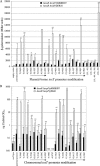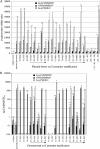Identification of the TcpP-binding site in the toxT promoter of Vibrio cholerae and the role of ToxR in TcpP-mediated activation
- PMID: 20679441
- PMCID: PMC2950353
- DOI: 10.1128/IAI.00566-10
Identification of the TcpP-binding site in the toxT promoter of Vibrio cholerae and the role of ToxR in TcpP-mediated activation
Abstract
ToxR-dependent recruitment of TcpP to the toxT promoter facilitates toxT transcription in Vibrio cholerae, initiating a regulatory cascade that culminates in cholera toxin expression and secretion. Although TcpP usually requires ToxR to activate the toxT promoter, TcpP overexpression can circumvent the requirement for ToxR in this process. To define nucleotides critical for TcpP-dependent promoter recognition and activation, a series of toxT promoter derivatives with single-base-pair transversions spanning the TcpP-binding site were generated and used as plasmid-borne toxT-lacZ fusions, as DNA mobility shift targets, and as allelic replacements of the chromosomal toxT promoter. When present in ΔtoxR V. cholerae overexpressing TcpP, several transversions affecting nucleotides within two direct repeats present in the TcpP-binding region (TGTAA-N(6)-TGTAA) caused defects in TcpP-dependent toxT-lacZ fusion activation and toxin production. Electrophoretic mobility shift assays demonstrated that these same transversions reduced the affinity of the toxT promoter for TcpP. The presence of ToxR suppressed transcription activation defects associated with most, but not all, transversions. Particularly, the central thymine nucleotide of both pentameric repeats was essential for efficient toxT activation, even in the presence of ToxR. These results suggest that the toxT promoter recognition function provided by ToxR can facilitate the interaction of TcpP with the toxT promoter but is insufficient for promoter activation when the TcpP-binding site has been severely compromised by mutation. Thus, the interaction of TcpP with nucleotides of the direct repeat sequences appears to be a prerequisite for toxT promoter activation.
Figures





Similar articles
-
The Vibrio cholerae ToxR/TcpP/ToxT virulence cascade: distinct roles for two membrane-localized transcriptional activators on a single promoter.Mol Microbiol. 2000 Oct;38(1):67-84. doi: 10.1046/j.1365-2958.2000.02111.x. Mol Microbiol. 2000. PMID: 11029691
-
ToxR recognizes a direct repeat element in the toxT, ompU, ompT, and ctxA promoters of Vibrio cholerae to regulate transcription.Infect Immun. 2013 Mar;81(3):884-95. doi: 10.1128/IAI.00889-12. Epub 2013 Jan 7. Infect Immun. 2013. PMID: 23297386 Free PMC article.
-
Independent Promoter Recognition by TcpP Precedes Cooperative Promoter Activation by TcpP and ToxR.mBio. 2021 Oct 26;12(5):e0221321. doi: 10.1128/mBio.02213-21. Epub 2021 Sep 7. mBio. 2021. PMID: 34488449 Free PMC article.
-
Co-ordinate expression of virulence genes by ToxR in Vibrio cholerae.Mol Microbiol. 1992 Feb;6(4):451-8. doi: 10.1111/j.1365-2958.1992.tb01489.x. Mol Microbiol. 1992. PMID: 1560773 Review.
-
Regulation of virulence in Vibrio cholerae: the ToxR regulon.Future Microbiol. 2007 Jun;2(3):335-44. doi: 10.2217/17460913.2.3.335. Future Microbiol. 2007. PMID: 17661707 Review.
Cited by
-
On or Off: Life-Changing Decisions Made by Vibrio cholerae Under Stress.Infect Microbes Dis. 2020 Oct 14;2(4):127-135. doi: 10.1097/IM9.0000000000000037. eCollection 2020 Dec. Infect Microbes Dis. 2020. PMID: 38630076 Free PMC article. Review.
-
Vibrio cholerae senses human enteric α-defensin 5 through a CarSR two-component system to promote bacterial pathogenicity.Commun Biol. 2022 Jun 8;5(1):559. doi: 10.1038/s42003-022-03525-3. Commun Biol. 2022. PMID: 35676416 Free PMC article.
-
TcpP L152A Constitutively Activating Virulence Gene Expression in Vibrio cholerae.Curr Microbiol. 2019 May;76(5):583-589. doi: 10.1007/s00284-019-01659-y. Epub 2019 Mar 2. Curr Microbiol. 2019. PMID: 30826907
-
Transcriptional regulator MarT negatively regulates MarT-regulated motility gene I, a new gene involved in invasion and virulence of Salmonella enterica.Front Microbiol. 2024 Aug 15;15:1430982. doi: 10.3389/fmicb.2024.1430982. eCollection 2024. Front Microbiol. 2024. PMID: 39211323 Free PMC article.
-
The wing of the ToxR winged helix-turn-helix domain is required for DNA binding and activation of toxT and ompU.PLoS One. 2019 Sep 9;14(9):e0221936. doi: 10.1371/journal.pone.0221936. eCollection 2019. PLoS One. 2019. PMID: 31498842 Free PMC article.
References
-
- Blanco, A. G., M. Sola, F. X. Gomis-Ruth, and M. Coll. 2002. Tandem DNA recognition by PhoB, a two-component signal transduction transcriptional activator. Structure 10:701-713. - PubMed
-
- Higgins, D. E., and V. J. DiRita. 1994. Transcriptional control of toxT, a regulatory gene in the ToxR regulon of Vibrio cholerae. Mol. Microbiol. 14:17-29. - PubMed
Publication types
MeSH terms
Substances
Grants and funding
LinkOut - more resources
Full Text Sources
Molecular Biology Databases

